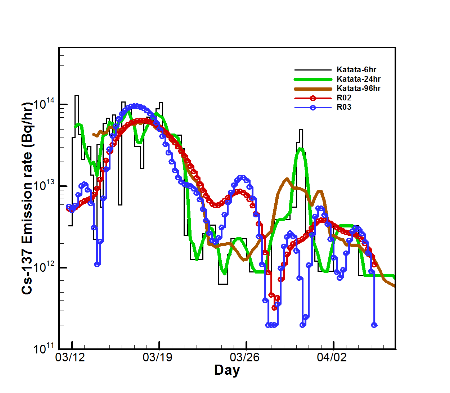
Comparison of HYSPLIT Cesium-137 emission estimates and Katata et al. (2015) results. Smoothness parameters are 1.0 and 0.1 for R02 and R03, respectively.
The Hybrid Single Particle Lagrangian Integrated Trajectory (HYSPLIT) model developed at NOAA’s Air Resources Laboratory has been widely used to study the atmospheric pollutant transport and dispersion in both forward and backward modes. Among those applications, the backward trajectory of a single pollutant particle is often used to identify the potential source locations.
A HYSPLIT inverse system has been built to quantify the source strength and temporal variations utilizing in-situ or remote sensing measurements. In this top-down approach, the unknown emission terms are obtained by searching the emissions that would provide the best model predictions closely matching the observations.
Under a 4D-Var framework, a cost function is defined to mostly measure the differences between model and observations at different time and locations, weighted by model and observation uncertainties. A background term is included to measure the deviation of the emission estimation from its first guess and it ensures that the problem is well-posed even when there are not enough observations available in certain circumstances. Other regularization terms may be included in the cost function.
The system has been successfully applied to the Fukushima nuclear power plant accident to estimate the release of the radionuclide caesium-137. Applications for volcanic ash and wildfire smoke source term estimations are also available.

Detection of fires over the southeastern US on 10 November 2016 using HYSPLIT inverse modeling. True-color images from MODIS (left), GASP AOD (middle), and ASDTA AOD (right) are shown.

Detection of fires over the southeastern region of the United States on November 10, 2016: True-color image from MODIS (left), MODIS AOD (top right), GASP AOD (middle right) and smoke AOD (bottom right)
For more information:
- Inverse modeling of fire emissions constrained by smoke plume transport using HYSPLIT dispersion model and geostationary observations. Kim, H. C., Chai, T., Stein, A., and Kondragunta (2020), S. Atmos. Chem. Phys., 20, 10259–10277, https://doi.org/10.5194/acp-20-10259-2020
- Source term estimation using air concentration measurements and a Lagrangian dispersion model – Experiments with pseudo and real cesium-137 observations from the Fukushima nuclear accident, Chai et al. 2015 https://doi.org/10.1016/j.atmosenv.2015.01.070
- NOAA’s HYSPLIT atmospheric transport and dispersion modeling system, Stein et al. 2015
- IWAQFR presentation – Sept. 2015

